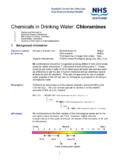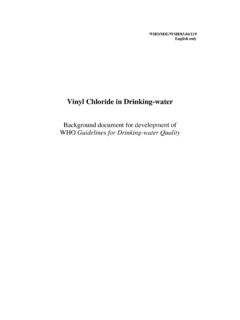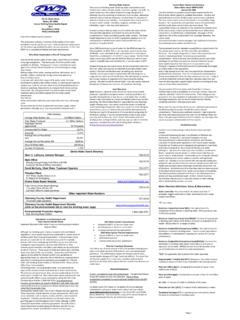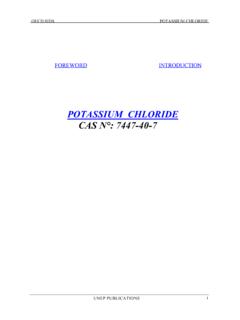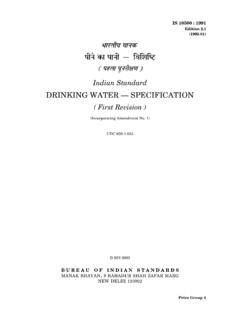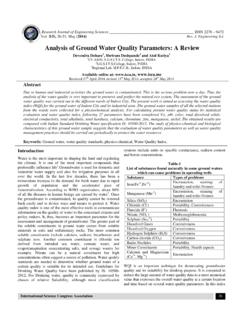Transcription of Chloride in Drinking-water - WHO | World Health …
1 WHO/SDE/ onlyChloride in drinking -waterBackground document for developmentWHO Guidelines for Drinking-water Quality_____Originally published in Guidelines for Drinking-water quality, 2nd ed. Vol. 2. Health criteria andother supporting information, World Health organization , Geneva, 1996. World Health organization 2003 All rights reserved. Publications of the World Health organization can be obtained fromMarketing and Dissemination, World Health organization , 20 Avenue Appia, 1211 Geneva27, Switzerland (tel: +41 22 791 2476; fax: +41 22 791 4857; email: for permission to reproduce or translate WHO publications whether for sale or fornoncommercial distribution should be addressed to Publications, at the above address (fax:+41 22 791 4806.))
2 Email: designations employed and the presentation of the material in this publication do notimply the expression of any opinion whatsoever on the part of the World Health Organizationconcerning the legal status of any country, territory, city or area or of its authorities, orconcerning the delimitation of its frontiers or mention of specific companies or of certain manufacturers products does not imply thatthey are endorsed or recommended by the World Health organization in preference to othersof a similar nature that are not mentioned. Errors and omissions excepted, the names ofproprietary products are distinguished by initial capital World Health organization does not warrant that the information contained in thispublication is complete and correct and shall not be liable for any damages incurred as a resultof its of the primary goals of WHO and its member states is that all people, whatevertheir stage of development and their social and economic conditions, have the right tohave access to an adequate supply of safe drinking water .
3 A major WHO function toachieve such goals is the responsibility to propose regulations, and to makerecommendations with respect to international Health matters .. The first WHO document dealing specifically with public Drinking-water quality waspublished in 1958 as International Standards for Drinking-water . It was subsequentlyrevised in 1963 and in 1971 under the same title. In 1984 1985, the first edition of theWHO Guidelines for Drinking-water quality (GDWQ) was published in threevolumes: Volume 1, Recommendations; Volume 2, Health criteria and othersupporting information; and Volume 3, Surveillance and control of communitysupplies. Second editions of these volumes were published in 1993, 1996 and 1997,respectively.
4 Addenda to Volumes 1 and 2 of the second edition were published in1998, addressing selected chemicals. An addendum on microbiological aspectsreviewing selected microorganisms was published in GDWQ are subject to a rolling revision process. Through this process, microbial,chemical and radiological aspects of Drinking-water are subject to periodic review,and documentation related to aspects of protection and control of public Drinking-water quality is accordingly the first edition of the GDWQ, WHO has published information on healthcriteria and other supporting information to the GDWQ, describing the approachesused in deriving guideline values and presenting critical reviews and evaluations ofthe effects on human Health of the substances or contaminants examined in each chemical contaminant or substance considered.
5 A lead institution prepared ahealth criteria document evaluating the risks for human Health from exposure to theparticular chemical in Drinking-water . Institutions from Canada, Denmark, Finland,France, Germany, Italy, Japan, Netherlands, Norway, Poland, Sweden, UnitedKingdom and United States of America prepared the requested Health the responsibility of the coordinators for a group of chemicals considered in theguidelines, the draft Health criteria documents were submitted to a number ofscientific institutions and selected experts for peer review. Comments were taken intoconsideration by the coordinators and authors before the documents were submittedfor final evaluation by the experts meetings. A final task force meeting reviewed thehealth risk assessments and public and peer review comments and, where appropriate,decided upon guideline values.
6 During preparation of the third edition of the GDWQ,it was decided to include a public review via the World wide web in the process ofdevelopment of the Health criteria the preparation of Health criteria documents and at experts meetings, carefulconsideration was given to information available in previous risk assessments carriedout by the International Programme on Chemical Safety, in its Environmental HealthCriteria monographs and Concise International Chemical Assessment Documents, theInternational Agency for Research on Cancer, the joint FAO/WHO Meetings onPesticide Residues, and the joint FAO/WHO Expert Committee on Food Additives(which evaluates contaminants such as lead, cadmium, nitrate and nitrite in addition tofood additives).
7 Further up-to-date information on the GDWQ and the process of their development isavailable on the WHO internet site and in the current edition of the work of the following coordinators was crucial in the development of thisbackground document for development of WHO Guidelines for drinking - Fawell, water Research Centre, United Kingdom (inorganic constituents)U. Lund, water Quality Institute, Denmark (organic constituents and pesticides)B. Mintz, Environmental Protection Agency, USA (disinfectants and disinfectant by-products)The WHO coordinators were as follows:Headquarters:H. Galal-Gorchev, International Programme on Chemical SafetyR. Helmer, Division of Environmental HealthRegional Office for Europe:X.
8 Bonnefoy, Environment and HealthO. Espinoza, Environment and HealthMs Marla Sheffer of Ottawa, Canada, was responsible for the scientific editing of efforts of all who helped in the preparation and finalization of this document,including those who drafted and peer reviewed drafts, are gratefully convening of the experts meetings was made possible by the financial support afforded toWHO by the Danish International Development Agency (DANIDA), Norwegian Agency forDevelopment Cooperation (NORAD), the United Kingdom Overseas DevelopmentAdministration (ODA) and the water Services Association in the United Kingdom, theSwedish International Development Authority (SIDA), and the following sponsoringcountries.
9 Belgium, Canada, France, Italy, Japan, Netherlands, United Kingdom of GreatBritain and Northern Ireland and United States of DESCRIPTIONI dentityChlorides are widely distributed in nature as salts of sodium (NaCl), potassium (KCl), andcalcium (CaCl2).Physicochemical properties (1)SaltSolubility in coldwater(g/litre)Solubility in hotwater(g/litre)Sodium chloride357391 Potassium chloride344567 Calcium chloride7451590 Organoleptic propertiesThe taste threshold of the Chloride anion in water is dependent on the associated cation. Tastethresholds for sodium Chloride and calcium Chloride in water are in the range 200 300mg/litre (2). The taste of coffee is affected if it is made with water containing a chlorideconcentration of 400 mg/litre as sodium Chloride or 530 mg/litre as calcium Chloride (3).
10 Major usesSodium Chloride is widely used in the production of industrial chemicals such as caustic soda,chlorine, sodium chlorite, and sodium hypochlorite. Sodium Chloride , calcium Chloride , andmagnesium Chloride are extensively used in snow and ice control. Potassium Chloride is usedin the production of fertilizers (4).Environmental fateChlorides are leached from various rocks into soil and water by weathering. The Chloride ionis highly mobile and is transported to closed basins or METHODSA number of suitable analytical techniques are available for Chloride in water , including silvernitrate titration with chromate indicator (5), mercury(II) nitrate titration withdiphenylcarbazone indicator, potentiometric titration with silver nitrate, automated iron(III)mercury(II) thiocyanate colorimetry, Chloride ion-selective electrode, silver colorimetry, andion chromatography.










